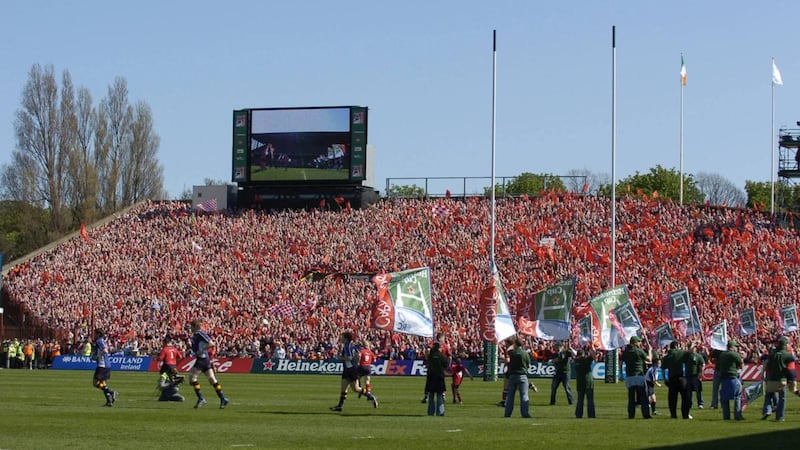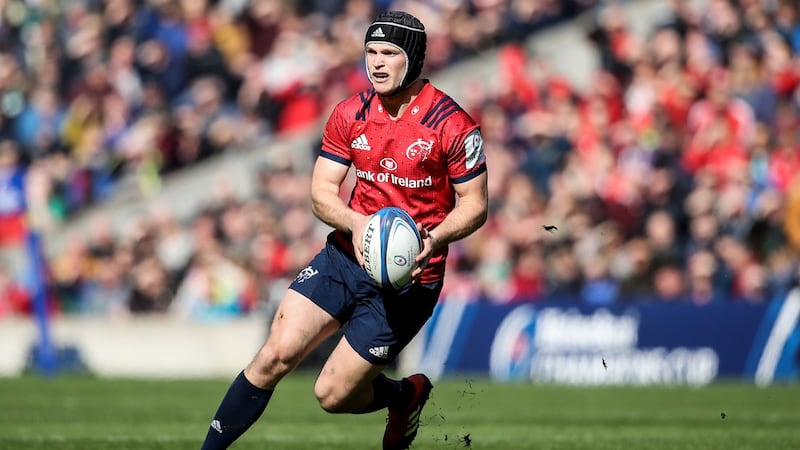My Wexford upbringing, and entire value system, should have protected this column from ever penning a Munster eulogy. But it had to happen at some stage simply because they tap into the emotional element essential for sporting success better than any other group.
We, the rugby people of Leinster, have gathered much knowledge from them. Of that we should be grateful. Eventually, jealousy bordering on hatred was channelled in the correct manner.

I’m talking about 2009 and Croke Park again because such an occasion could be revisited on May 11th. It’s sneaking up on everyone but an All Ireland final at St James’s Park is a very real possibility. I expect the champions to find a way past Toulouse while Munster, even without Joey Carbery, are primed to get over their semi-final hump.
European success is ingrained in Munster rugby as much as their great days are weaved into the fabric of Irish rugby.
Keith Earls is the last playing link to 2008, but what a connection he represents all the way back to his father Ger on those Young Munster teams in the Killing Fields of Tom Clifford Park.

History matters in Munster. I know this too well. We, of Leinster, were motivated by their successes in 2006 and 2008 perhaps more than anyone else. Perhaps even more then they were.
That’s because we suffered at their hand in the 2006 semi. I’ll never forget the sea of red when coming out for the warm-up at Lansdowne Road. Our home game stolen from us by the more passionate fan base. Pick-pocketed on and off the pitch.
You never forget, but you can do something about it.
Munster’s truly epic victories in southern France, those final defeats to Northampton and Leicester before finally beating Biarritz then Toulouse to win two Heineken Cups stung Leinster players as much as it brought joy to our Ireland team-mates. We could only look on, brimful of talent yet lacking the ruthless instinct needed to capture silverware.
Stability starts at the top of any organisation and works its way into every pore. Michael Cheika brought that to Leinster after Gary Ella and Declan Kidney came and went in quick succession. Munster, having extended Johann van Graan’s contract until 2022, have sent out a clear message: this young South African is the man to lead us into our shared future. Not to point the finger at Rassie Erasmus but he said all the right things, speaking about building something special in Limerick, but his one-and-done season – which will never be forgotten for so many reasons – is what came to pass.
Re-signing van Graan creates an environment for Munster to revisit their glorious past. Success in Irish rugby requires a settled group. We can’t purchase trophies but we can recruit the men capable of delivering it.
That is our shared history.
A collaborative structure appears to be in place on the UL campus with Jerry Flannery and Felix Jones growing as assistant coaches while the player group have embraced the plan.
Tangible evidence came from the defensive display against Edinburgh at Murrayfield.
In 2009, Leinster rose up and won the Heineken Cup when Munster were seemingly at their peak. It pains me to write this, but there would be no greater show of Irish rugby strength, especially after the Six Nations, than the sight of Peter O’Mahony lifting the Champions Cup in Newcastle.
Here’s hoping Pete and Co run onto the hallowed turf for Geordie footballers – from Kevin Keegan to Alan Shearer to Gazza – but fall short in a game for the ages.
Despite losing Carbery to injury, Munster are better equipped than previous semi-final defeats, against Saracens in 2017 and Racing 92 last year, to overcome the bones of England’s pack in Coventry on Saturday week.
That’s due to several factors with coaching stability and Carbery’s influence on Tyler Bleyendaal top of the list.
Spatial awareness is almost a new skill for a southern hemisphere flyhalf playing in this part of the world
We are about to find out if Munster are anywhere near good enough to win the tournament. It’s proven year on year that the champions must first topple previous winners.
Munster have always been about being more than the sum of their parts. It took Leinster a while to figure that out.
Earls epitomises the Munster way. A try-scoring winger should in theory be selfish to the point of naked arrogance (you can think of a few) but Keith is hard working and humble to a fault.
Earls was on the bench in 2008 against Toulouse so that would hold personal motivations, but it is all about the team, because that’s what he was born into. Munster are back on the right path. The final has been in touching distance for three years now. Hope didn’t last long in the previous semis so their immediate goal would be to stay in the fight against Sarries’ guaranteed power surge.
Machine
Saracens are a machine again. It has taken them until now to recover from the Lions tour of New Zealand but the 2017 champions boast five of the pack – Billy Vunipola, Mako Vunipola, Maro Itoje, George Kruis and Jamie George – that “bullied” Ireland at the Aviva in February. Then there is Owen Farrell and Liam Williams.
They are unfairly perceived as a money-backed club, but they also place a lot of stock in the person and not just the player they bring into their community.
That’s what makes them such a force. That’s what makes this seem like an almost insurmountable task for Munster.
That said, van Graan will see a real opportunity as Saracens have looked beatable this season. Ignore the quarter-final as Glasgow failed to give them a game.

So much rests on Bleyendaal’s performance. The assumption is a 20-something Kiwi arrives in Europe as the finished article. I disagree in this case. There have been improvements in Bleyendaal’s game since Joey went south last summer.
Spatial awareness is almost a new skill for a southern hemisphere flyhalf playing in this part of the world. It’s practically a different position. We tend to attack around the fringes of rucks, be it off nine or 10, whichCarbery does better than any other player in Ireland because of his threat with ball in hand. We hear that Bleyendaal’s rugby IQ is on another level – it’s the body that has let him down – and I see the way he has tailored his game.
Also, I can see Carbery’s improvements since being handed the Munster 10 jersey following a couple of seasons working under Johnny Sexton.
The role of the 10, up here, is largely about creating mismatches in tight spaces. For example, take the Jacob Stockdale try against Scotland. O’Mahony took the lineout near halfway before Conor Murray passed to Seán O’Brien who passed to Garry Ringrose who won the gainline. The Scottish backrow and midfield came up expecting a strike move off first phase but Ireland were only laying the platform to create a mismatch. Quick enough ball saw Murray feed O’Mahony who fed Sexton, running hard to the line, on a little switch play. Johnny was the bait which Scotland prop Allan Dell swallowed as an inside pass, just as Dell emptied Sexton, allowed Stockdale sprint clear for a 45m try.
Munster can replace the above names with Jack O’Donoghue, Chris Farrell, Bleyendaal and Andrew Conway.
Bleyendaal is clever enough to fill this role. It can be a painful existence as his natural instincts ever since childhood in New Zealand would be to stand in a deeper role but Sexton proves the template for success is playing flat to the line.
Yes, I’m turning a glaring negative into a positive but that’s how Munster must view the loss of their young superstar.
Leinster have refused to blink every time Sexton has been unavailable. Ross Byrne is trusted and encouraged to make it his team.
Bleyendaal – who, like Jamison Gibson Park, is a break-glass-in-case-of-emergency World Cup option – has the chance to atone for his 2017 semi-final performance and live up to the scintillating form of five years ago that had Canterbury folk heralding the second coming of Dan Carter.
Munster signed him to become their long-term outhalf solution. His moment is now.
Perfect scenario
I am jumping the gun but this feels like the season when blue and red descend on Newcastle for one fine day. Eventually the financial might of other English and French clubs will reduce the chances of perennial semi-final appearances from Leinster and Munster. Toulouse could be sensational on their return to Dublin but they are very young. So, picture the perfect scenario, Leinster and Munster to progress.
If so, my blood will run blue. Munster’s dream return to their glory days, ending an 11-year wait, will understandably capture the neutral rugby supporter but I shall remain unapologetically biased.
History shows Munster to be the ultimate bandwagon team to follow (we lost plenty of Leinster people in the early 2000s). They are the ultimate underdog story, van Graan can tap into that well of motivation.
Me, I’d still prefer to be training out of UCD every morning.
The beauty of the Irish system is how these April days can focus the mind. Nobody lingers on the Six Nations. Japan is 6,000 miles and five months away away. These players are not dragging themselves out of bed for a win bonus or fat pay cheque. If the body was willing, I’d come out of retirement for free in a heartbeat. It’s about wearing the jersey. Stag or harp on crest, the passion runs deep.
For that alone I am grateful to Munster.
















